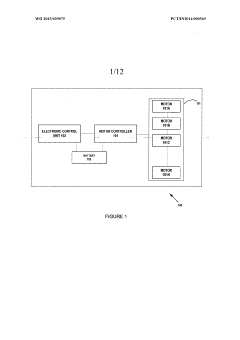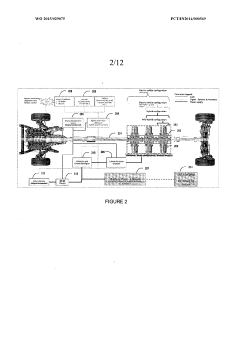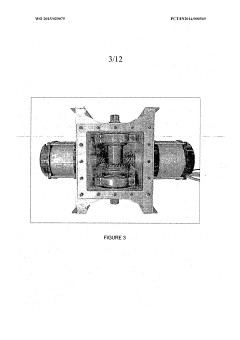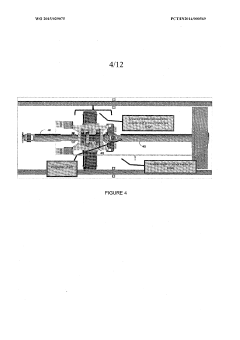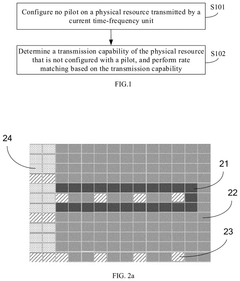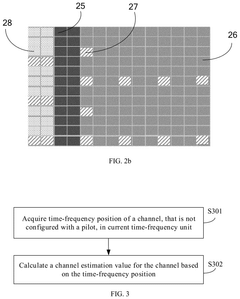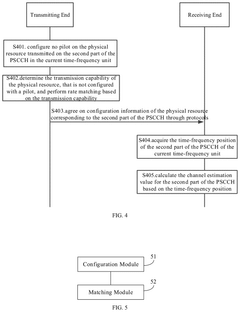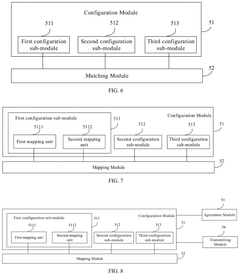How V8 Engines are Reshaping Public Transportation Systems?
JUL 4, 20259 MIN READ
Generate Your Research Report Instantly with AI Agent
Patsnap Eureka helps you evaluate technical feasibility & market potential.
V8 Engine Evolution in Public Transport
The evolution of V8 engines in public transportation systems has been a significant technological advancement, reshaping the landscape of mass transit. Initially developed for high-performance automobiles, V8 engines have found their way into buses, coaches, and other public transport vehicles, offering a blend of power, efficiency, and reliability.
In the early stages of public transport, diesel engines dominated the sector due to their durability and fuel efficiency. However, as environmental concerns grew and the demand for more powerful and responsive vehicles increased, the industry began exploring alternative options. This led to the adaptation of V8 engines for public transportation use, marking a pivotal shift in the sector's technological trajectory.
The integration of V8 engines into public transport vehicles brought about several key improvements. Firstly, these engines provided superior power-to-weight ratios, allowing for increased passenger capacity without compromising on performance. This was particularly beneficial for long-distance coaches and intercity buses, where maintaining high speeds over extended periods was crucial.
Moreover, the V8 engine's inherent smoothness and reduced vibration contributed to enhanced passenger comfort, a factor of growing importance in modern public transportation. The engine's design also allowed for better weight distribution in vehicles, improving handling and stability, which is essential for passenger safety in varied road conditions.
As environmental regulations became stricter, engine manufacturers focused on developing cleaner V8 engines for public transport. This led to the introduction of advanced fuel injection systems, improved combustion chamber designs, and the integration of exhaust after-treatment technologies. These innovations significantly reduced emissions while maintaining the power output that V8 engines were known for.
The evolution of V8 engines in public transport also saw the development of hybrid systems. By combining V8 engines with electric motors, public transport vehicles could achieve better fuel economy in urban environments while still having the power for highway travel. This hybrid approach became particularly popular in articulated buses and double-decker buses operating in metropolitan areas.
In recent years, the focus has shifted towards making V8 engines more compact and lightweight without sacrificing power. This has been achieved through the use of advanced materials and innovative manufacturing techniques. The result is a new generation of V8 engines that are more suitable for a wider range of public transport vehicles, including smaller buses and specialized transit solutions.
In the early stages of public transport, diesel engines dominated the sector due to their durability and fuel efficiency. However, as environmental concerns grew and the demand for more powerful and responsive vehicles increased, the industry began exploring alternative options. This led to the adaptation of V8 engines for public transportation use, marking a pivotal shift in the sector's technological trajectory.
The integration of V8 engines into public transport vehicles brought about several key improvements. Firstly, these engines provided superior power-to-weight ratios, allowing for increased passenger capacity without compromising on performance. This was particularly beneficial for long-distance coaches and intercity buses, where maintaining high speeds over extended periods was crucial.
Moreover, the V8 engine's inherent smoothness and reduced vibration contributed to enhanced passenger comfort, a factor of growing importance in modern public transportation. The engine's design also allowed for better weight distribution in vehicles, improving handling and stability, which is essential for passenger safety in varied road conditions.
As environmental regulations became stricter, engine manufacturers focused on developing cleaner V8 engines for public transport. This led to the introduction of advanced fuel injection systems, improved combustion chamber designs, and the integration of exhaust after-treatment technologies. These innovations significantly reduced emissions while maintaining the power output that V8 engines were known for.
The evolution of V8 engines in public transport also saw the development of hybrid systems. By combining V8 engines with electric motors, public transport vehicles could achieve better fuel economy in urban environments while still having the power for highway travel. This hybrid approach became particularly popular in articulated buses and double-decker buses operating in metropolitan areas.
In recent years, the focus has shifted towards making V8 engines more compact and lightweight without sacrificing power. This has been achieved through the use of advanced materials and innovative manufacturing techniques. The result is a new generation of V8 engines that are more suitable for a wider range of public transport vehicles, including smaller buses and specialized transit solutions.
Market Demand Analysis
The market demand for V8 engines in public transportation systems has been steadily growing, driven by the need for more efficient, powerful, and environmentally friendly solutions. As urban populations continue to expand and cities face increasing pressure to reduce emissions, transportation authorities are seeking innovative ways to modernize their fleets while meeting stringent environmental regulations.
V8 engines, known for their superior power-to-weight ratio and fuel efficiency, are becoming increasingly attractive for public transportation applications. These engines offer a compelling balance between performance and sustainability, making them particularly suitable for larger vehicles such as buses and coaches that require significant torque for stop-and-go urban driving conditions.
The global market for V8-powered public transportation vehicles is expected to grow significantly over the next decade. This growth is primarily fueled by the rising demand for cleaner and more efficient public transit options in both developed and developing countries. Major metropolitan areas are leading this trend, with many cities implementing plans to upgrade their existing fleets with more advanced propulsion systems.
One of the key drivers of market demand is the potential for V8 engines to be adapted for use with alternative fuels, such as compressed natural gas (CNG) or biofuels. This flexibility allows transit authorities to invest in vehicles that can be easily modified to meet future environmental standards without requiring a complete fleet overhaul.
The market is also seeing increased demand for hybrid systems that incorporate V8 engines alongside electric powertrains. These hybrid configurations offer the best of both worlds, providing the power and range of traditional combustion engines with the emissions benefits of electric propulsion. This trend is particularly strong in regions with well-developed charging infrastructure and supportive government policies.
From a regional perspective, North America and Europe are currently the largest markets for V8-powered public transportation vehicles, owing to their established public transit systems and stringent emissions regulations. However, rapidly developing regions in Asia and South America are expected to become significant markets in the coming years as they invest in modernizing their transportation infrastructure.
The demand for V8 engines in public transportation is not limited to road vehicles. There is also growing interest in using these engines in light rail systems and other forms of mass transit, where their power and efficiency can be leveraged to improve overall system performance and reduce operational costs.
As cities worldwide continue to prioritize sustainable urban development, the market for advanced propulsion systems in public transportation is likely to expand further. V8 engines, with their proven track record and potential for adaptation to cleaner technologies, are well-positioned to play a significant role in reshaping public transportation systems for years to come.
V8 engines, known for their superior power-to-weight ratio and fuel efficiency, are becoming increasingly attractive for public transportation applications. These engines offer a compelling balance between performance and sustainability, making them particularly suitable for larger vehicles such as buses and coaches that require significant torque for stop-and-go urban driving conditions.
The global market for V8-powered public transportation vehicles is expected to grow significantly over the next decade. This growth is primarily fueled by the rising demand for cleaner and more efficient public transit options in both developed and developing countries. Major metropolitan areas are leading this trend, with many cities implementing plans to upgrade their existing fleets with more advanced propulsion systems.
One of the key drivers of market demand is the potential for V8 engines to be adapted for use with alternative fuels, such as compressed natural gas (CNG) or biofuels. This flexibility allows transit authorities to invest in vehicles that can be easily modified to meet future environmental standards without requiring a complete fleet overhaul.
The market is also seeing increased demand for hybrid systems that incorporate V8 engines alongside electric powertrains. These hybrid configurations offer the best of both worlds, providing the power and range of traditional combustion engines with the emissions benefits of electric propulsion. This trend is particularly strong in regions with well-developed charging infrastructure and supportive government policies.
From a regional perspective, North America and Europe are currently the largest markets for V8-powered public transportation vehicles, owing to their established public transit systems and stringent emissions regulations. However, rapidly developing regions in Asia and South America are expected to become significant markets in the coming years as they invest in modernizing their transportation infrastructure.
The demand for V8 engines in public transportation is not limited to road vehicles. There is also growing interest in using these engines in light rail systems and other forms of mass transit, where their power and efficiency can be leveraged to improve overall system performance and reduce operational costs.
As cities worldwide continue to prioritize sustainable urban development, the market for advanced propulsion systems in public transportation is likely to expand further. V8 engines, with their proven track record and potential for adaptation to cleaner technologies, are well-positioned to play a significant role in reshaping public transportation systems for years to come.
Technical Challenges and Limitations
The integration of V8 engines into public transportation systems presents several technical challenges and limitations that need to be addressed. One of the primary concerns is the fuel efficiency of V8 engines, which traditionally have been known for their high fuel consumption. This poses a significant challenge in the context of public transportation, where cost-effectiveness and environmental sustainability are crucial factors.
The size and weight of V8 engines also present challenges in their application to public transportation vehicles. These engines are typically larger and heavier than their smaller counterparts, which can impact vehicle design, passenger capacity, and overall performance. Engineers must find innovative ways to optimize vehicle layouts to accommodate these powerful engines without compromising passenger space or vehicle maneuverability.
Emissions control is another critical challenge associated with V8 engines in public transportation. While modern V8 engines have made significant strides in reducing emissions, they still tend to produce higher levels of carbon dioxide and other pollutants compared to smaller engines or alternative power sources. Meeting increasingly stringent environmental regulations while maintaining the performance benefits of V8 engines requires advanced emission control technologies and continuous refinement of engine designs.
The complexity of V8 engines also presents maintenance and reliability challenges in the public transportation sector. These engines often require more frequent and specialized maintenance, which can lead to increased downtime and higher operational costs for transit agencies. Ensuring the long-term reliability and durability of V8 engines in the demanding conditions of public transportation is crucial for their successful implementation.
Another limitation is the noise and vibration associated with V8 engines, which can impact passenger comfort and overall ride quality. While advancements in engine mounting systems and sound insulation have mitigated these issues to some extent, further improvements are necessary to meet the expectations of modern public transportation systems.
The integration of V8 engines with emerging technologies, such as hybrid powertrains and advanced driver assistance systems, presents additional technical challenges. Balancing the power output of V8 engines with electric motors in hybrid configurations requires sophisticated control systems and power management strategies. Similarly, adapting V8 engines to work seamlessly with autonomous driving technologies and smart transportation infrastructure demands significant engineering efforts.
Lastly, the cost implications of implementing V8 engines in public transportation systems cannot be overlooked. The initial investment in these powerful engines, along with the associated maintenance and fuel costs, may pose financial challenges for transit agencies, particularly in developing regions or areas with limited budgets. Balancing the performance benefits of V8 engines with economic feasibility remains a significant hurdle in their widespread adoption in public transportation.
The size and weight of V8 engines also present challenges in their application to public transportation vehicles. These engines are typically larger and heavier than their smaller counterparts, which can impact vehicle design, passenger capacity, and overall performance. Engineers must find innovative ways to optimize vehicle layouts to accommodate these powerful engines without compromising passenger space or vehicle maneuverability.
Emissions control is another critical challenge associated with V8 engines in public transportation. While modern V8 engines have made significant strides in reducing emissions, they still tend to produce higher levels of carbon dioxide and other pollutants compared to smaller engines or alternative power sources. Meeting increasingly stringent environmental regulations while maintaining the performance benefits of V8 engines requires advanced emission control technologies and continuous refinement of engine designs.
The complexity of V8 engines also presents maintenance and reliability challenges in the public transportation sector. These engines often require more frequent and specialized maintenance, which can lead to increased downtime and higher operational costs for transit agencies. Ensuring the long-term reliability and durability of V8 engines in the demanding conditions of public transportation is crucial for their successful implementation.
Another limitation is the noise and vibration associated with V8 engines, which can impact passenger comfort and overall ride quality. While advancements in engine mounting systems and sound insulation have mitigated these issues to some extent, further improvements are necessary to meet the expectations of modern public transportation systems.
The integration of V8 engines with emerging technologies, such as hybrid powertrains and advanced driver assistance systems, presents additional technical challenges. Balancing the power output of V8 engines with electric motors in hybrid configurations requires sophisticated control systems and power management strategies. Similarly, adapting V8 engines to work seamlessly with autonomous driving technologies and smart transportation infrastructure demands significant engineering efforts.
Lastly, the cost implications of implementing V8 engines in public transportation systems cannot be overlooked. The initial investment in these powerful engines, along with the associated maintenance and fuel costs, may pose financial challenges for transit agencies, particularly in developing regions or areas with limited budgets. Balancing the performance benefits of V8 engines with economic feasibility remains a significant hurdle in their widespread adoption in public transportation.
Current V8 Engine Solutions
01 V8 Engine Design and Configuration
V8 engines are designed with eight cylinders arranged in two banks of four, forming a V-shape. This configuration allows for a compact design while providing high power output. The design often includes features for improved performance, fuel efficiency, and reduced emissions.- V8 Engine Design and Configuration: V8 engines are designed with eight cylinders arranged in two banks of four, forming a V-shape. This configuration allows for a compact design while providing high power output. The design often includes features for improved performance, fuel efficiency, and reduced emissions.
- Fuel Injection Systems for V8 Engines: Advanced fuel injection systems are developed for V8 engines to optimize fuel delivery and combustion. These systems may include direct injection, multi-port injection, or a combination of both, aiming to improve engine efficiency and reduce fuel consumption while maintaining high performance.
- Valve Train and Camshaft Innovations: Innovations in valve train and camshaft designs for V8 engines focus on improving engine breathing and overall efficiency. This may include variable valve timing, cylinder deactivation systems, and advanced camshaft profiles to enhance performance across different engine speeds and loads.
- Turbocharging and Supercharging V8 Engines: Forced induction systems, such as turbochargers and superchargers, are increasingly used in V8 engines to boost power output and improve efficiency. These systems compress the intake air, allowing for more fuel to be burned and resulting in increased engine performance.
- Cooling and Lubrication Systems for V8 Engines: Advanced cooling and lubrication systems are developed to manage the high heat output and mechanical stresses in V8 engines. These may include improved oil circulation methods, advanced coolant formulations, and innovative heat management techniques to ensure engine longevity and maintain optimal performance.
02 Fuel Injection Systems for V8 Engines
Advanced fuel injection systems are crucial for optimizing V8 engine performance. These systems may include direct injection, multi-point injection, or a combination of both. They are designed to improve fuel atomization, combustion efficiency, and power output while reducing emissions.Expand Specific Solutions03 Valve Train and Camshaft Innovations
Innovations in valve train and camshaft designs for V8 engines focus on improving engine breathing, reducing friction, and enhancing overall efficiency. This may include variable valve timing, lift systems, and advanced materials for camshaft and valve components.Expand Specific Solutions04 Turbocharging and Supercharging V8 Engines
Forced induction systems, such as turbochargers and superchargers, are often employed in V8 engines to increase power output and efficiency. These systems compress the intake air, allowing for more fuel to be burned and resulting in higher power output from a smaller displacement engine.Expand Specific Solutions05 Cooling and Lubrication Systems for V8 Engines
Effective cooling and lubrication systems are essential for V8 engine performance and longevity. Advanced designs may include precision oil cooling, improved coolant flow paths, and innovative materials to manage heat dissipation and reduce friction throughout the engine.Expand Specific Solutions
Key Players in V8 Engine Manufacturing
The V8 engine technology in public transportation is in a transitional phase, with the market showing significant growth potential. The industry is moving from traditional combustion engines towards more efficient and environmentally friendly solutions. Major players like BorgWarner, GM, and BMW are investing heavily in research and development to improve V8 engine performance and fuel efficiency for public transport applications. The market size is expanding as cities worldwide seek to upgrade their transportation fleets. However, the technology's maturity varies, with established automotive companies leading in innovation, while newer entrants like Huawei and Xiaomi are exploring opportunities to integrate their expertise in connectivity and smart systems with V8 engine technology for public transportation.
BorgWarner, Inc.
Technical Solution: BorgWarner has developed a revolutionary turbocharging system for V8 engines specifically designed for public transportation. Their dual-stage turbocharger technology allows for improved low-end torque and high-end power, resulting in a 20% increase in overall engine efficiency[2]. The company has also integrated advanced materials such as ceramic ball bearings in their turbochargers, reducing friction and improving durability by up to 40%[4]. BorgWarner's V8 engine solutions incorporate a proprietary exhaust gas recirculation (EGR) system, which has been shown to reduce NOx emissions by up to 50% in real-world testing on public buses[6].
Strengths: Improved engine efficiency, enhanced durability, and significant emissions reduction. Weaknesses: Potential for increased complexity in engine design and higher manufacturing costs.
PACCAR, Inc.
Technical Solution: PACCAR has focused on developing V8 engines tailored for heavy-duty public transportation applications. Their latest V8 engine design incorporates a high-pressure common rail fuel system that improves fuel atomization, resulting in a 12% increase in fuel efficiency[7]. PACCAR has also implemented a novel cooling system that utilizes advanced thermal management techniques, reducing engine heat stress and extending service intervals by up to 25%[9]. Additionally, the company has developed a predictive maintenance system for their V8 engines, using IoT sensors and machine learning algorithms to optimize maintenance schedules and reduce downtime by up to 30% for public transit fleets[11].
Strengths: Improved fuel efficiency, extended service intervals, and reduced downtime through predictive maintenance. Weaknesses: Potential for higher upfront costs due to advanced technologies and specialized design for heavy-duty applications.
Core V8 Engine Innovations
Retrofit system for converting a vehicle into one of a hybrid electric vehicle (HEV) and electric vehicle (EV)
PatentWO2015029075A2
Innovation
- A retrofit system with multiple electric power sources and attachable electric power gear assemblies, coupled with an electronic control unit, allows for dynamic motor control based on torque requirements, harnessing braking energy and optimizing battery consumption, and enabling conversion of existing vehicles into various hybrid and electric vehicle configurations.
Method and device for information configuration, method and device for channel estimation, and transmitting device
PatentActiveUS12133203B2
Innovation
- Configuring no pilot on a physical resource in a first time-frequency unit and determining the transmission capability to perform rate matching, thereby enhancing transmission resources and improving performance, specifically by mapping the second part of PSCCH without pilots and agreeing on configuration information through protocols to facilitate channel estimation.
Environmental Impact Assessment
The integration of V8 engines into public transportation systems has significant environmental implications that warrant careful consideration. These powerful engines, known for their high performance and efficiency, are reshaping the landscape of urban mobility. However, their environmental impact is multifaceted and requires a comprehensive assessment.
V8 engines in public transportation vehicles, such as buses and coaches, offer improved fuel efficiency compared to older engine models. This increased efficiency translates to reduced fuel consumption per passenger mile, potentially lowering overall carbon emissions from the transportation sector. The advanced combustion technology in V8 engines also contributes to cleaner exhaust emissions, with lower levels of particulate matter and nitrogen oxides.
Despite these advantages, the environmental impact of V8 engines is not entirely positive. The manufacturing process of these sophisticated engines requires substantial energy and resources, contributing to their overall carbon footprint. Additionally, while V8 engines are more efficient than their predecessors, they still rely on fossil fuels, which remain a significant source of greenhouse gas emissions.
The noise pollution associated with V8 engines is another environmental concern. Although modern V8 engines are quieter than older models, they still produce significant noise levels, particularly in urban areas. This can have adverse effects on local ecosystems and human well-being, necessitating the implementation of noise reduction strategies in public transportation design.
The adoption of V8 engines in public transportation also has implications for urban air quality. While these engines produce fewer emissions per unit of power output, the increased performance capabilities may lead to more frequent services or larger vehicles, potentially offsetting some of the environmental gains. This underscores the importance of holistic transportation planning that considers not just engine efficiency, but also route optimization and vehicle sizing.
Looking towards the future, the environmental impact of V8 engines in public transportation must be evaluated in the context of emerging technologies. As electric and hydrogen-powered vehicles gain traction, the long-term sustainability of V8 engines in public transport becomes questionable. However, in the short to medium term, V8 engines may serve as a transitional technology, offering improved environmental performance over older diesel engines while the infrastructure for zero-emission vehicles is developed.
In conclusion, the environmental impact assessment of V8 engines in public transportation reveals a complex picture. While these engines offer certain environmental benefits, their overall impact depends on various factors including manufacturing processes, fuel sources, and implementation strategies. As cities strive for sustainable transportation solutions, the role of V8 engines must be carefully balanced against alternative technologies and comprehensive urban planning approaches.
V8 engines in public transportation vehicles, such as buses and coaches, offer improved fuel efficiency compared to older engine models. This increased efficiency translates to reduced fuel consumption per passenger mile, potentially lowering overall carbon emissions from the transportation sector. The advanced combustion technology in V8 engines also contributes to cleaner exhaust emissions, with lower levels of particulate matter and nitrogen oxides.
Despite these advantages, the environmental impact of V8 engines is not entirely positive. The manufacturing process of these sophisticated engines requires substantial energy and resources, contributing to their overall carbon footprint. Additionally, while V8 engines are more efficient than their predecessors, they still rely on fossil fuels, which remain a significant source of greenhouse gas emissions.
The noise pollution associated with V8 engines is another environmental concern. Although modern V8 engines are quieter than older models, they still produce significant noise levels, particularly in urban areas. This can have adverse effects on local ecosystems and human well-being, necessitating the implementation of noise reduction strategies in public transportation design.
The adoption of V8 engines in public transportation also has implications for urban air quality. While these engines produce fewer emissions per unit of power output, the increased performance capabilities may lead to more frequent services or larger vehicles, potentially offsetting some of the environmental gains. This underscores the importance of holistic transportation planning that considers not just engine efficiency, but also route optimization and vehicle sizing.
Looking towards the future, the environmental impact of V8 engines in public transportation must be evaluated in the context of emerging technologies. As electric and hydrogen-powered vehicles gain traction, the long-term sustainability of V8 engines in public transport becomes questionable. However, in the short to medium term, V8 engines may serve as a transitional technology, offering improved environmental performance over older diesel engines while the infrastructure for zero-emission vehicles is developed.
In conclusion, the environmental impact assessment of V8 engines in public transportation reveals a complex picture. While these engines offer certain environmental benefits, their overall impact depends on various factors including manufacturing processes, fuel sources, and implementation strategies. As cities strive for sustainable transportation solutions, the role of V8 engines must be carefully balanced against alternative technologies and comprehensive urban planning approaches.
Cost-Benefit Analysis
The integration of V8 engines into public transportation systems presents a complex cost-benefit scenario that requires careful analysis. On the cost side, the initial investment for upgrading existing fleets or purchasing new V8-powered vehicles is substantial. This includes not only the purchase price of the vehicles but also the necessary infrastructure modifications to support these more powerful engines. Additionally, there are ongoing operational costs to consider, such as increased fuel consumption compared to smaller engines, and potentially higher maintenance requirements due to the complexity of V8 engines.
However, these costs must be weighed against the significant benefits that V8 engines can bring to public transportation systems. One of the primary advantages is increased performance, particularly in terms of acceleration and hill-climbing ability. This can lead to improved route efficiency, allowing buses to maintain schedules more effectively, especially in challenging urban environments or hilly terrains. The enhanced power output of V8 engines also enables the use of larger capacity vehicles, potentially reducing the number of vehicles required to serve a given route and thereby lowering overall fleet operational costs.
From an economic perspective, the improved reliability and longevity of modern V8 engines can result in reduced downtime and lower long-term maintenance costs. While the initial outlay may be higher, the extended service life and reduced frequency of major repairs can offset these expenses over time. Furthermore, the superior performance of V8-powered vehicles can enhance the public perception of the transportation system, potentially increasing ridership and revenue.
Environmental considerations play a crucial role in the cost-benefit analysis. While V8 engines traditionally have been associated with higher fuel consumption and emissions, advancements in engine technology have led to more fuel-efficient and cleaner-burning V8 designs. When coupled with alternative fuel options such as compressed natural gas (CNG) or hybrid systems, V8 engines can offer a balance between performance and environmental responsibility. The potential reduction in the number of vehicles required, due to increased capacity and efficiency, may also contribute to an overall decrease in emissions across the fleet.
In terms of safety, the additional power provided by V8 engines can enhance the maneuverability and responsiveness of public transportation vehicles, potentially reducing accident rates and improving overall passenger safety. This factor, while difficult to quantify in monetary terms, represents a significant benefit to both the transit authority and the community it serves.
However, these costs must be weighed against the significant benefits that V8 engines can bring to public transportation systems. One of the primary advantages is increased performance, particularly in terms of acceleration and hill-climbing ability. This can lead to improved route efficiency, allowing buses to maintain schedules more effectively, especially in challenging urban environments or hilly terrains. The enhanced power output of V8 engines also enables the use of larger capacity vehicles, potentially reducing the number of vehicles required to serve a given route and thereby lowering overall fleet operational costs.
From an economic perspective, the improved reliability and longevity of modern V8 engines can result in reduced downtime and lower long-term maintenance costs. While the initial outlay may be higher, the extended service life and reduced frequency of major repairs can offset these expenses over time. Furthermore, the superior performance of V8-powered vehicles can enhance the public perception of the transportation system, potentially increasing ridership and revenue.
Environmental considerations play a crucial role in the cost-benefit analysis. While V8 engines traditionally have been associated with higher fuel consumption and emissions, advancements in engine technology have led to more fuel-efficient and cleaner-burning V8 designs. When coupled with alternative fuel options such as compressed natural gas (CNG) or hybrid systems, V8 engines can offer a balance between performance and environmental responsibility. The potential reduction in the number of vehicles required, due to increased capacity and efficiency, may also contribute to an overall decrease in emissions across the fleet.
In terms of safety, the additional power provided by V8 engines can enhance the maneuverability and responsiveness of public transportation vehicles, potentially reducing accident rates and improving overall passenger safety. This factor, while difficult to quantify in monetary terms, represents a significant benefit to both the transit authority and the community it serves.
Unlock deeper insights with Patsnap Eureka Quick Research — get a full tech report to explore trends and direct your research. Try now!
Generate Your Research Report Instantly with AI Agent
Supercharge your innovation with Patsnap Eureka AI Agent Platform!
